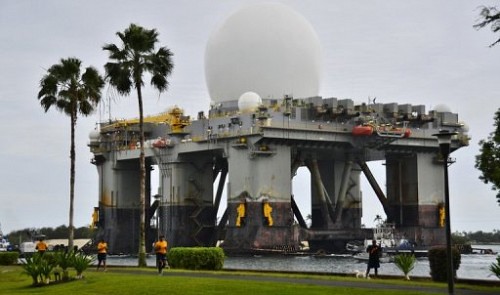US deploys sea-based radar amid N. Korea tensions
WASHINGTON (AFP) - The United States has deployed a sophisticated radar off the coast of Japan capable of tracking North Korean missiles and has sent a second destroyer to the region, officials said Tuesday.

This March 22, 2013 handout image provided by the US Navy shows the Sea-based, X-band Radar (SBX 1).
The Sea-Based X-Band Radar (SBX), which resembles an enormous balloon mounted on a large oil rig, is designed to track ballistic missiles and feed data to a separate command that can fire interceptors.
Pentagon spokesman George Little stressed the deployment of the SBX system had already been scheduled and was not related to the ongoing tensions surrounding North Korea.
"The SBX is undergoing scheduled sea trials. Decisions about further deployments have not been made at this point," Little said.
"It's incorrect to tie the SBX at this point to what's happening on the Korean Peninsula right now."
Earlier, US officials confirmed that the anti-missile destroyer USS John McCain has been deployed to the region. The Pentagon at first said that a similar type of destroyer, the USS Fitzgerald, had been deployed.
Later on Tuesday Little said the USS Decatur anti-missile destroyer had also been sent to the Pacific region.
"It's arrived at a predetermined location in the Western Pacific to perform a missile defense mission," he said, stressing that reports saying US ships would be based off the North Korean coast were "incorrect."
"Those assets also help protect our own interests, our own troops in the region and other allies, to include Japan," he said.
"Our response, and the mix of assets we have supplied to our responses, is prudent, logical and measured."
"Let me be very clear that the United States' position is that we want peace and stability on the Korean Peninsula."
In recent days the United States has sent its most sophisticated weapons to the region in a display of gunboat diplomacy.
The United States previously took the unusual step of announcing test bombing by nuclear-capable state-of-the-art B-2 bombers.
It has also deployed F-22 Raptor stealth fighters to South Korea as part of a US-South Korean military exercise -- dubbed "Foal Eagle" -- which is scheduled to last until April 30.
The Korean peninsula has been caught in a cycle of escalating tensions since the North's February nuclear test, which followed a long-range rocket launch in December.
Subsequent UN sanctions and annual South Korea-US military exercises have been used by Pyongyang to justify a wave of increasingly dire threats against Seoul and Washington, including warnings of missile strikes and nuclear war.

This March 22, 2013 handout image provided by the US Navy shows the Sea-based, X-band Radar (SBX 1).
The Sea-Based X-Band Radar (SBX), which resembles an enormous balloon mounted on a large oil rig, is designed to track ballistic missiles and feed data to a separate command that can fire interceptors.
Pentagon spokesman George Little stressed the deployment of the SBX system had already been scheduled and was not related to the ongoing tensions surrounding North Korea.
"The SBX is undergoing scheduled sea trials. Decisions about further deployments have not been made at this point," Little said.
"It's incorrect to tie the SBX at this point to what's happening on the Korean Peninsula right now."
Earlier, US officials confirmed that the anti-missile destroyer USS John McCain has been deployed to the region. The Pentagon at first said that a similar type of destroyer, the USS Fitzgerald, had been deployed.
Later on Tuesday Little said the USS Decatur anti-missile destroyer had also been sent to the Pacific region.
"It's arrived at a predetermined location in the Western Pacific to perform a missile defense mission," he said, stressing that reports saying US ships would be based off the North Korean coast were "incorrect."
"Those assets also help protect our own interests, our own troops in the region and other allies, to include Japan," he said.
"Our response, and the mix of assets we have supplied to our responses, is prudent, logical and measured."
"Let me be very clear that the United States' position is that we want peace and stability on the Korean Peninsula."
In recent days the United States has sent its most sophisticated weapons to the region in a display of gunboat diplomacy.
The United States previously took the unusual step of announcing test bombing by nuclear-capable state-of-the-art B-2 bombers.
It has also deployed F-22 Raptor stealth fighters to South Korea as part of a US-South Korean military exercise -- dubbed "Foal Eagle" -- which is scheduled to last until April 30.
The Korean peninsula has been caught in a cycle of escalating tensions since the North's February nuclear test, which followed a long-range rocket launch in December.
Subsequent UN sanctions and annual South Korea-US military exercises have been used by Pyongyang to justify a wave of increasingly dire threats against Seoul and Washington, including warnings of missile strikes and nuclear war.
Comments
Post a Comment